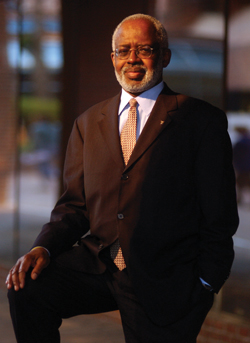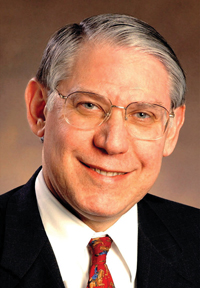
George Hill, Ph.D., associate dean for Diversity in Medical Education.
Photo by Dana Johnson
Strategic plan to boost student, faculty diversity

Steven Gabbe, M.D.
Vanderbilt University School of Medicine is implementing a four-year diversity strategic plan aimed at attracting more top-tier minority medical and graduate students as well as faculty, residents and fellows.
African Americans, His-panics and Native Americans represent more than 25 percent of the U.S. population but only 6 percent of the physician population.
“We find ourselves competing as a group of medical schools for a small pool of top medical students and for a small pool of top faculty,” School of Medicine Dean Steven Gabbe said. “It is very difficult.”
“I think it is important that we define diversity very broadly — racial, ethnic, sexual, socioeconomic.”
Gabbe chairs a Liaison Committee on Medical Education (LCME) that is looking at how the incentives, or “teeth,” in advancing diversity can be made stronger in the accreditation process. The LCME examines all U.S. medical schools periodically.
One major challenge with the Vanderbilt plan will be to attract diverse faculty members, a group in high demand at medical schools throughout the country.
“The pool of faculty, the number of faculty from diverse backgrounds, is largely limited,” Gabbe said. “We need to enhance that pool by having a more diverse group of medical students who become a diverse group of house officers that we can then recruit into fellowships and faculty.
“We hope that our sister schools will do the same and together we will create a broader, larger pool of potential faculty members.”
Vanderbilt Associate Dean for Diversity in Medical Education George Hill, Ph.D., is VUMC's only tenured full-time African-American faculty member.
Among clinical faculty, Radiology professor Harold Thompson is the only African-American who is tenured.
“This has to be a concentrated effort we make to get more tenure track faculty in the system, to get more faculty who are in the tenure track through to tenure, and to get more clinical faculty here who are members of underrepresented minorities,” said Hill, the Levi Watkins Jr., Professor in Medical Education.
“We are very, very low. We have to do a better job at it.”
The plan provides Vanderbilt with four major goals, essentially a blueprint to pursue progress and evaluate achievements on a periodic basis, beginning with a top priority to recruit and retain qualified persons from underrepresented minority backgrounds.
The second goal is to educate students, house staff and faculty on the importance of cultural competency in the provision of health care to patients, which could include expanding the depth of curricular focus and educational opportunities for diversity and cultural competence.
Efforts to support communication that values and enhances the institutional commitment to diversity and develop evaluation systems to measure progress in the proposed diversity strategic plan are the final two goals.
“We need to gather data in order to evaluate our progress in achieving racial and ethnic diversity, as well as other targeted diversity, among students, faculty, administration and health care providers,” Hill said.
A VUSM Diversity Task Force will monitor progress toward these goals and submit an annual report to the dean.
“The most important thing we can do initially is develop a task force that can set priorities,” Hill said. “One of the areas that has to be high priority is faculty.”
Hill is serving as Vanderbilt's institutional coordinator for the Leadership Alliance, a consortium united by a shared vision of greater diversity in the nation's institutes of higher learning.
The Alliance, which recently accepted both Vanderbilt and Dillard universities, was established in 1992 to address the shortage of underrepresented minorities in graduate programs in the sciences.
It has since expanded its mission to encourage underrepresented groups to seek careers that require training and research in a variety of disciplines and fields.













